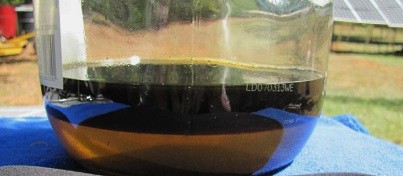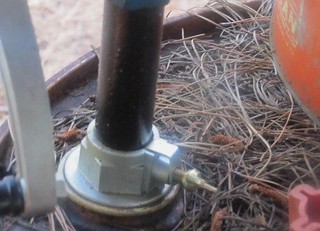 One of the benefits of maintaining the Backdoor Survival website is that I am often asked to review various products of interest to the preparedness community. I have personally tested and used all of the products I have written up and as you know, it is always more than a simple “two-liner” or just the rewrite of a pile technical specs or press releases.
One of the benefits of maintaining the Backdoor Survival website is that I am often asked to review various products of interest to the preparedness community. I have personally tested and used all of the products I have written up and as you know, it is always more than a simple “two-liner” or just the rewrite of a pile technical specs or press releases.
But there are some products that I can’t effectively review because the Survival Husband and I do not always have the necessary review tools. In such cases, I occasionally turn to my long-time friend George Ure at Urban Survival, who’s one of the “old hands” at prepping, having exited from big city life in early 2003.
Living on a ranch (more of a tree farm now) in East Texas, he has everything needed to review fuel preservation solutions like the ones offered by the PRI-D folks which quite coincidentally, readers have also asked about.
For those of you that are not familiar with fuel additives, Power Research Inc. manufactures fuel both gas and diesel fuel preservation products and will be providing the product of choice to one lucky reader – but more about that later.
First, here is the report from George.
Secrets of Successful Diesel Storage
When we moved up to our slice of the Outback , we were typical city-slickers, although I’d worked a bit summers as a boy in Eastern Washington, I got my first D-6 Cat bulldozer stuck in soft dirt along Crab Creek (just over the hill from Hanford) at age 12. Ever since then, my relation with diesels has had its ups and downs.
A diesel engine is an incredibly simple machine, at least in principle. There is no ignition system, per se. As a cylinder is about to begin its compression stroke, a high pressure pump squirts a precise amount of fuel into the cylinder. Because air heats when it’s compressed enough, eventually, with a compression ratio up over 20 to 1 in many cases, the injected fuel explodes and that’s where the power comes from.
To be sure, compression ratios as low as 14 can be used, but there are tradeoffs, not the least of which is the ability to fire off on cold mornings. A typical farm tractor may have diesel with under 20:1 compression, but in these instances, the engine is usually equipped with a pre-heater (or glow) plug.
In cold weather starts, the glow plug is run for 15-seconds, or so, and then cranking begins.
If you’re ever in a survival situation with a diesel engine, there was an old trick used by SeaBees during WW II when they were cat-skinning in Alaska to start cranky diesels on cold mornings: They’d shove a rag into the exhaust pipe! Believe it, or not, this small increase in back-pressure into the engine was sometimes enough to light off a cranky diesel.
Gaye’s product review offer couldn’t have come at a better time, since I’ve been having one of the “downs” in my relationship with diesels. The reason, as it turns out was simple enough when I took a small sample of diesel out of one of our 55-gallon storage drums to see what the fuel looked like. Not pretty…
Using an old wine jug, I let the fuel settle for a day and snapped this picture. What it shows is two layers had formed. The bottom one was clear liquid – water with some barrel rust in it and other impurities – while the top layer above was a kind of gooey tar-like substance.
You’ll see in the pictures as we go through my report here, a kind of “red” cast to the diesel. That’s because agricultural use diesel (“ag-diesel”) has red dye added to it so you can be caught and fined for running farm diesel on the highway if you have a diesel powered car or truck and the inclination to be something of a chiseler on taxes.
On the other hand, farm diesel runs just fine and presumably, in the event of a National Emergency, or whatever, bureaucrats would have other worries than handing out fines for running lower tax diesel, but you never know about these things, so it’s a judgment call on your part.
Be advised, in many states, especially Texas, you need to have a state-issued permit just to buy the farm diesel and you’ll periodically get polled by mail that you still operate a farm or ranch and are a legitimate user of farm-dyed red diesel if you’re not running “road” diesel.
After reading through the brochure from PRI-D, I found confirmation of what I had previously (and wrongheadedly) thought was algae in the dark goo layer. Not so. It turns out that when diesel is refined, it’s not just a single level distillate in the cracking tower of the refinery.
So it’s not algae, but rather some of the cracked “tars” and heavier distillates getting back together again and they can turn into fairly large tar-ball goo and that’s not going to run nicely, since it can plug up the fuel oil filter and muck up the diesel fuel pump.
Diesel can include something of a range of distillates when being made, more so than gasoline for sure, and depending on how much of what is used in the diesel blend, there may be more of the heavier distillates than the lighter products used in gasoline. That, plus heat (or time) is what caused diesel to go bad. While PRI-D is already well-established for keeping diesel from break down well past the advertised 10-year mark, my problem was a little different. I wanted to get the diesel back into useful condition after it has goo ’ed up…that was my problem at hand.
Why so much focus on diesel? It comes down to two reasons, really: One is in fuel weight. For reference, a gallon of water weighs 8-pounds (“A pint’s a pound, the world around”). Gasoline weighs about 6-pounds per gallon and diesel (depending on blend and temperature) will come in around 7.1-pounds per gallon.
I know…you’re thinking “Does that mean diesel, gallon for gallon can get more work done?” Absolutely. If you look over here at the gallon equivalent of gasoline tables, you’ll see that base gasoline has about 114,000 British Thermal Units of heating power (potential work) per gallon. But diesel has 129,500 BTU’s worth or almost 13.3% more work in it for a given volume of product.
Diesels are even starting to move into some unique applications, too. For example, the Aircraft Owners and Pilots Association recently reported on Lycoming’s drive to introduce a Jet-A fuel burning diesel to the aviation market. Presently in the US, low lead av-gas is cheap compared to Europe where it can top $20 a gallon. Diesel airplanes may have a bright future.
Those are dreams for the tractor-ing set, mostly, so back to my wine jug sample: It seemed obvious to me that somehow water had gotten into my tank (the one that was open) but I didn’t think nearly this much water would come in simply due to condensation. Upon doing some inspection after a heavy rainfall, I found (thanks to wind) that I was getting enough water onto the tank-top that unfortunately a few drops had gotten in the fuel.
And, to make matters worse, there was also a fair amount of pine needles that had accumulated on the drum.
If you’ve got a sharp eye for farmerly things, you’ll notice the distinct lack of rust on the manual rotary pump fitting that screws into the top of the tank. That’s because this is one of those fancy aluminum pumps which I spent a few extra bucks on, thinking it would pay off.
Save your money: This one hasn’t lasted any longer than the previous one, which I got just four years of service from. The problem is the pump vanes inside the pump head deteriorate fairly quickly, so I’ve got a note on my “farm supplies list” to pick up another back-up diesel pump. To be sure, you can get diesel moved around with a syphon, but getting a mouthful of diesel is not something you’ll be anxious to do often, although I’ve been reduced to it a few times in a pinch, but a bulb-type diesel and gas transfer system can be had at Amazon which will make life easier if (should I say when?) the vane typed rotary pump fails.
The next step in the review was to load up some jugs of diesel and put them side-by-side to see how they would clean up with PRI-D added to one, but not the other.
Here’s what the results looked like using a bit more than recommended (a tablespoon per gallon) after three minutes:
It was pretty obvious that the PRI-D was doing its magic, breaking down the gobs into something that my old Kubota could digest more happily!
After letting the jugs sit for a while, as the one on the right continued to clarify more over the next hour or two, it was becoming clear that what my Dirty Diesel contained was being sorted into three layers.
I didn’t get pictures of it, but once the settling was done (I gave it 24-hours not because it needed more than a couple, but because I got busy around the ranch with other chores) I simply decanted off the good fuel into the tractor.
OK, fine, the PRI-D solved part of my problem, but that left a really ugly bunch of goo in the bottom of the wine jugs. What to do with that?
Eventually it dawned on me that I could collect those two bottom layers and toss them into a bucket. Once all the diesel had been polished (as fuel cleaning is called), I would simply wait until we get back into the rainy season here in East Texas and dump the residue onto a burn pile of fallen tree limbs and such that accumulate over a season, along with dead trees that get pushed up into monster brush piles which are then burned.
Burning as hot as a 15-foot wall of fire does, I figure that will be the end of my leftover residue problem.
Over the course of doing research for this article, I had developed a numbers of questions which Ralph Lewis of PRI-D was kind enough to answer, and in particular, I asked about the idea of adding some gas or diesel line dryer to the fuel to “suck some of the water” out and put it back into a form that might be passed into the engine to burn…
Heck, I thought that might have saved me some decanting work, right? No, bad plan explained Ralph’s email:
“One of the worst things you can do is to use a glycol/alcohol based additive to try to emulsify water in fuel. Never a good idea. Problem is simple. When encapsulated water hits a hot injector tip, it expands rapidly to steam and can literally distort or destroy the aperture of the injector. Any product that claims “makes water disappear” or “gets rid of water” is one to completely avoid!
Even so, most consumer additive makers make products for water emulsification – relying on the ignorance of the consumer in these matters. I suppose we could as well, but doing so would be a gross disservice to consumers.
Regarding long-term fuel storage – some simple practices will avoid the issue you observed. First – always best to keep tanks topped off, leaving little “head” space in which condensation will form. Second, always a good idea to have a good water separation filter on the tank intake line (assuming this is a large fuel tank). Third – a good idea to have a second water separation on the output line. I have attached a paper with fuel storage recommendations – mostly aimed at large commercial tanks, although they can apply to smaller tanks as well.
Personally, I keep all of my prep fuel stored in small plastic gas cans – and I keep them in a dry, cool place. Properly treated with PRI-G – or if diesel – with PRI-D – the fuel will literally last for many years. In fact, I had some fuel stored for 14 years, treated only once with PRI-G, that functioned perfectly when I finally used it.”
The main thing to plan on, if your prepping involves storing fuel, is to understand that fresh gasoline (no ethanol) left untreated may last only a year, or so, before it begins to “varnish” and, after that how your equipment reacts to it may be something of a crap-shoot.
One of the applications around the ranch (besides the tractor and back-up generator diesel fuel) where I’ve become something of a rabid convert is the PRI-G product where the G stands for gas. We have been on a vicious cycle the past few years of taking several piece of gear down to the local small engine shop every spring to get them running again after starter fluid and no end of curse words wouldn’t start them.
I’m banking on not doing that next year because I will end the season by running av-gas treated with PRI-G through them. Then, if I don’t take the time to get them running about mid-winter, it may not matter since the varnish is what gums up the carb floats and clogs jets, especially the low-speed idle just on small two-cycle engines.
As to the diesel? Well, I’ve now transitioned to the plastic tanks – which I’d picked up a while ago and those, I was told, were much less likely to collect condensation and, even better, they don’t rust.
And this brings me to one more oddity, which I picked up from carefully reading Power Research Incorporated (the PRI of the PRI-D and PRI-G products): They specifically say that the main factors impacting storage are: “Heat, water, copper or copper alloys, and zinc– should be excluded as much as possible.”
The Rules of Fuel Storage
Power Research also publishes a list of key things to keep in mind when storing fuel:
1. The product should be placed in underground storage.
2. If tankage is aboveground, it should be sheltered. Tanks and aboveground lines should be coated with reflective paint to minimize heating of the fuel.
3. Tank should be checked for product last stored to prevent contamination of fresh product.
4. All rust and tank scale should be removed.
5. Storage tank should be checked for water monthly, and more frequently in winter months.
6. If water is present, it should be removed at once by bleeding from the bottom of aboveground tanks or pumping it out of underground tanks.
7. In the event biological growth is found in the fuel tank, there are biocides that will destroy or control this type of contamination. The better practice is to keep the tank free of water.
8. If the tank is underground, make certain the fill stem is tight and protected to prevent seepage of ground water into the tank.
9. Check all pipe fittings for leakage.
1O. Make certain no zinc, copper or copper alloys come in contact with the fuel. Any found should be removed. Tanks and piping should be of suitable reinforced plastic. If plastic cannot be used, black iron is the second best choice.
11 Have suitable filters installed on dispensing equipment to remove any particulate material, which might collect in tank and contaminate the fuel.
12 If possible, provide a floating suction intake. The cleanest fuel is normally found at the uppermost level of the fuel.
13. A pressure/vacuum relief valve should be installed on aboveground gasoline tanks. Such valves must be checked periodically in freezing weather to assure that they are not frozen shut. A frozen pressure/vacuum valve can cause a tank to collapse when product is pumped out. Tanks with bolted tops must have a tight top seal.”
Now that I know what I’ve been doing wrong, I have added a couple of more points to their checklist:
14. Store your fuel out of the sun, at least in a shady area if you’re in hot country.
15. Insist on using plastic 55-gallons drums is possible.
16. Don’t leave the fuel pump in the diesel tank because it allows air and (in my case) water to get in, which will cause work down the road.
17. Have at least two or three barrel bung wrenches around – they aren’t too spendy.
18. If you’re gong to be moving fuel, the safety way is with a barrel lifting arm which can be had from Harbor Freight and other heavy-duty hardware outfits.
19. Keep your equipment tanks full after use. (This got drummed into me on airplanes, but remembering to do it after tractor-ing isn’t as easy as it sounds when images of a cool shower and visions of a cold Bud are dancing in your head.)
The 20th rule may be the most important of all:
Don’t store fuel or flammable liquids near any possible ignition source. I have had had plastic jugs develop cracked seams over time and so keep them all outside, away from the family home. Fire prevention is everyone’s job. Oh, and keep it under lock and key, as rule 20½ . There’s just too much trouble bad people (or kids) can get into with a five gallon jug of fuel!
Source:www.backdoorsurvival.com




